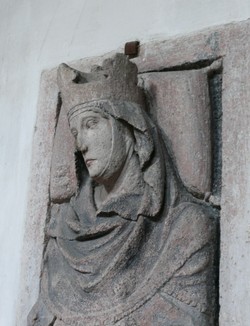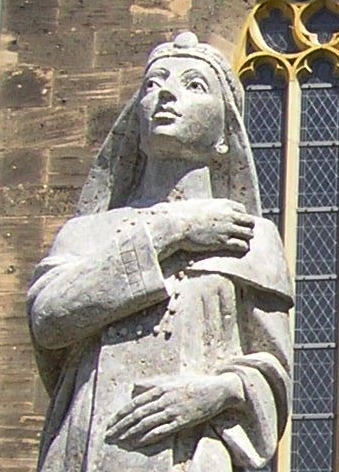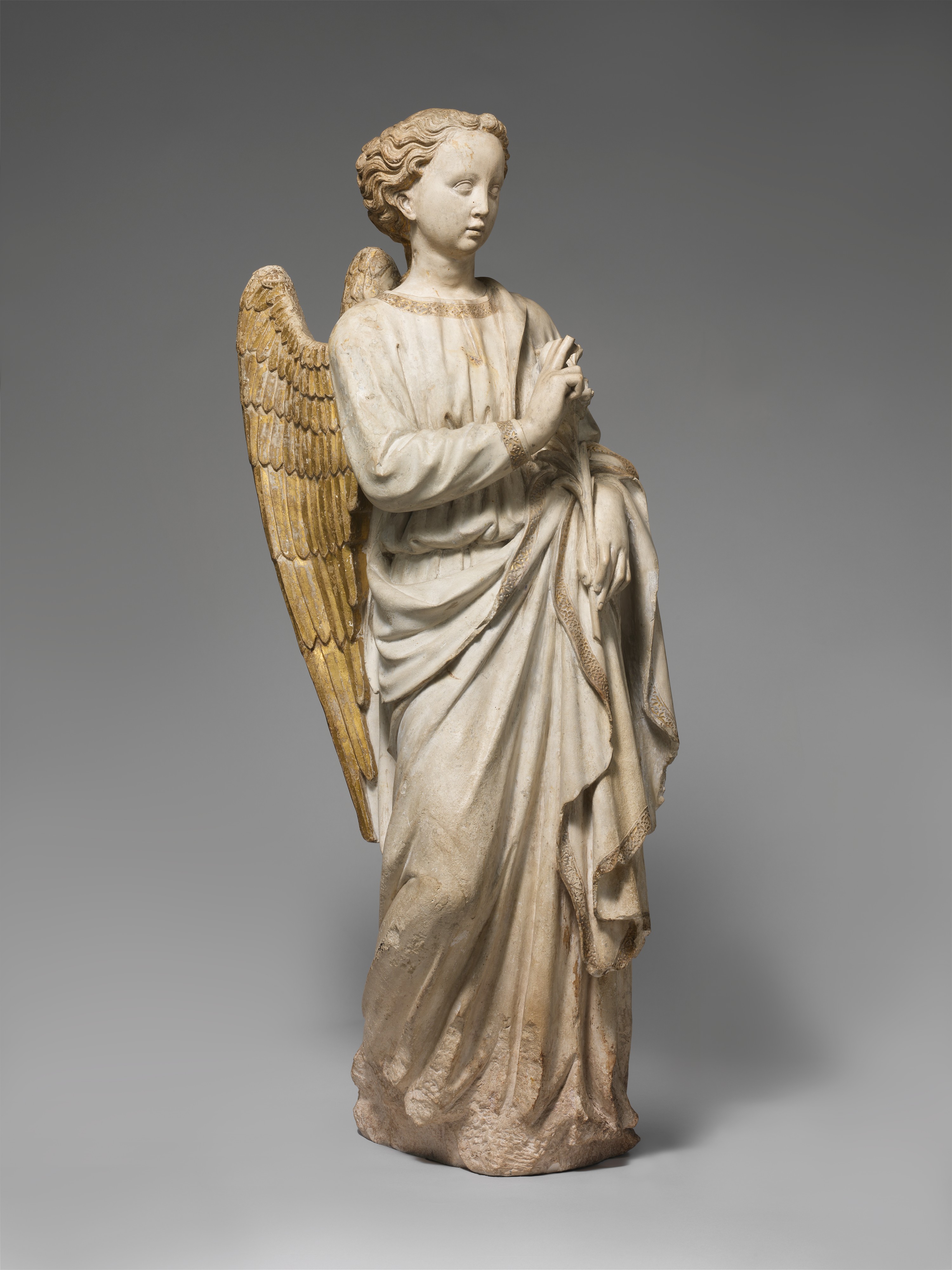|
Richardis
Saint Richardis (), also known as Richgard, Richardis of Swabia and Richarde de Souabe in French ( 840 – 18 September, between 894 and 896 AD), was empress of the Carolingian Empire as the wife of Charles the Fat. She was renowned for her piety and was the first abbess of Andlau. Repudiated by her husband, Richardis later became a Christian model of devotion and just rule. She was canonised in 1049. Life She was born in Alsace, the daughter of Erchanger, count of the Nordgau, of the family of the Ahalolfinger. She married Charles in 862 and was crowned with him in Rome by Pope John VIII in 881. The marriage was childless. Charles' reign was marked by internal and external strife, caused primarily by the constant plundering of Norman raiders on the northern French coast. These attacks had intensified as the aggressors, no longer content to pillage the coastline, had moved their attentions to cities and towns along the rivers. Powerless to resist the invasion of the Norm ... [...More Info...] [...Related Items...] OR: [Wikipedia] [Google] [Baidu] |
Saint
In Christianity, Christian belief, a saint is a person who is recognized as having an exceptional degree of sanctification in Christianity, holiness, imitation of God, likeness, or closeness to God in Christianity, God. However, the use of the term ''saint'' depends on the context and Christian denomination, denomination. In Anglican Communion, Anglican, Oriental Orthodox, and Lutheranism, Lutheran doctrine, all of their faithful deceased in Heaven are considered to be saints, but a selected few are considered worthy of greater honor or emulation. Official Ecclesiastical polity, ecclesiastical recognition, and veneration, is conferred on some denominational saints through the process of canonization in the Catholic Church or glorification in the Eastern Orthodox Church after their approval. In many Protestant denominations, and following from Pauline usage, ''saint'' refers broadly to any holy Christian, without special recognition or selection. While the English word ''saint'' ... [...More Info...] [...Related Items...] OR: [Wikipedia] [Google] [Baidu] |
Liutward
Liutward was the archchancellor of the Carolingian Empire from 878 and the bishop of Vercelli from 880 by appointment of Charles the Fat. Never liked by the nobility, he was trusted by Charles as a confidant and go-between with the papacy. In 887, he was accused by Charles of having an affair with the Empress Richardis and though the empress successfully underwent the ordeal of fire, he was banished from court. Liutward's men abducted the daughter of Unroch III of Friuli from a convent in Brescia and forced her to marry one of his relatives. This provoked enmity between Liutward, the chief Carolingian prelate in Lombardy, and Berengar of Friuli, the chief secular magnate. The famed poet of the age, Notker of St Gall Notker the Stammerer ( – 6 April 912), Notker Balbulus, or simply Notker, was a Benedictine monk at the Abbey of Saint Gall active as a composer, poet and scholar. Described as "a significant figure in the Western Church", Notker made substan ..., dedicated a ... [...More Info...] [...Related Items...] OR: [Wikipedia] [Google] [Baidu] |
List Of German Queens
Queen of the Romans (, ) or Queen of the Germans were the official titles of the queens consort of the medieval and early modern Kingdom of Germany. They were the wives of the King of the Romans (chosen by imperial election), and are informally also known as German queen (). A Queen of the Romans also became Holy Roman Empress if Coronation of the Holy Roman emperor, her husband was crowned Holy Roman Emperor, in the Middle Ages usually by the Pope in Rome during an ''Italienzug''. Most elected Kings of the Romans did, but some never made it that far, and thus their wives only ever achieved the status of Queen of the Romans. Empress Maria Theresa (1745–1780) is often considered to be a ruler suo jure, in her own right, as she was Queen regnant of Bohemia and Hungary, and although her husband Francis I, Holy Roman Emperor, Francis I was crowned Holy Roman Emperor in 1745, it was she who ruled the Empire and continued to do so even after Francis' death in 1765 before ruling join ... [...More Info...] [...Related Items...] OR: [Wikipedia] [Google] [Baidu] |
Théodrate Of Troyes
Théodrate of Troyes (also ''Théodérade, Théodrade''; 868—903) was the wife of Odo, Count of Paris and queen consort of West Francia In medieval historiography, West Francia (Medieval Latin: ) or the Kingdom of the West Franks () constitutes the initial stage of the Kingdom of France and extends from the year 843, from the Treaty of Verdun, to 987, the beginning of the Capet ... from 888 to 898. Evidence of Théodrate and Odo's children come from non-contemporary or historically inauthentic sources. The eleventh-century chronicler Adémar de Chabannes wrote that they had a son, Arnoul (c.882-898), who died shortly after his father Odo. Guy is named as one of the couple's children in an Alan I's charter dated 28 August 903, but genealogist Christian Settipani says it's a falsification.Christian Settipani. ''La Préhistoire des Capétiens (Nouvelle histoire généalogique de l'auguste maison de France)''. P. Van Kerrebrouck, 1993. p 402-403 References , - {{DEFA ... [...More Info...] [...Related Items...] OR: [Wikipedia] [Google] [Baidu] |
Adelaide Of Paris
Adélaïde of Paris (Aélis) (; 850/853 – 10 November 901) was a Frankish queen. She was the second wife of Louis the Stammerer, King of West Francia and mother of Charles the Simple. Life Adelaide was daughter of the count palatine Adalard of Paris. She was chosen by Charles the Bald, King of Western Francia, to marry his son and heir, Louis the Stammerer, despite the fact that Louis had secretly married Ansgarde of Burgundy against the wishes of his father. Although Louis and Ansgarde already had two children, Louis and Carloman, Charles prevailed upon Pope John VIII, to dissolve the union. This accomplished, Charles married his son to Adelaide in February 875. However, the marriage was called into question because of the close blood-kinship of the pair. When on 7 September 878 the pope crowned Louis (who had succeeded his father in the previous year), the pope refused to crown Adelaide. When Louis the Stammerer died in Compiegne on 10 April 879, Adelaide was pregnant, ... [...More Info...] [...Related Items...] OR: [Wikipedia] [Google] [Baidu] |
List Of Queens And Empresses Of France
This is a list of the women who were queens or empresses as wives of French monarchs from the 843 Treaty of Verdun, which gave rise to West Francia, until 1870, when the French Third Republic was declared. Living wives of reigning monarchs technically became queen consorts, including Margaret of Burgundy and Blanche of Burgundy who were kept in prison during their whole queenships. Carolingian dynasty (751-987) Capetian dynasty (987-1792, 1814-1815, 1815-1848) Direct Capetians (987-1328) House of Valois (1328-1589) House of Lancaster Some sources refer to Margaret of Anjou as Queen of France,Mary Ann Hookham: "The life and times of Margaret of Anjou, queen of England and France ", 1872 but her right to enjoy that title is disputed. She was briefly recognized only in English-controlled territories of France. (See also: Dual monarchy of England and France) Capetian dynasty House of Valois House of Bourbon (1589-1792) Françoise d'Aubigné, Marquise de M ... [...More Info...] [...Related Items...] OR: [Wikipedia] [Google] [Baidu] |
Ageltrude
Ageltrude or Agiltrude (around 860 – 27 August 923) was the Empress and Queen of Italy as the wife of Guy (reigned 891–894). She was the regent for her son Lambert (reigned 894–898) and actively encouraged him in opposing the Carolingians, and in influencing papal elections in their favour. Life Ageltrude was the daughter of Prince Adelchis of Benevento and Adeltrude. She married Guy of Spoleto circa 875, when he was the duke and margrave of Spoleto and Camerino. Guy of Spoleto defeated Berengar to became King of Italy in 889, and then, in 891, he was crowned Holy Roman Emperor, making Ageltrude empress. Guy's reign was short, and in 894, Guy died, leaving Ageltrude a widow. As their son, Lambert, was a minor, she became regent. In 894, Ageltrude accompanied her 14-year-old son, Lambert, to Rome to be confirmed as emperor by Pope Formosus, who supported the Carolingian claimant Arnulf of Carinthia. In 896, she and her son fled from Rome to Spoleto when Arnul ... [...More Info...] [...Related Items...] OR: [Wikipedia] [Google] [Baidu] |
Empress Of The Holy Roman Empire
The Holy Roman Empress or Empress of the Holy Roman Empire (''Kaiserin des Heiligen Römischen Reiches'') was the wife or widow of the Holy Roman Emperor. The elective dignity of Holy Roman emperor was restricted to males only, but some empresses, such as Theophanu and Maria Theresa, were ''de facto'' rulers of the Empire. Holy Roman Empresses Before 924, the title of emperor was not always associated with the German kingdom; rather, it was initially associated with the Carolingian dynasty, and then possessed by several other figures of the 9th and 10th centuries. Their wives were thus empresses, but not necessarily German queens. Carolingian Holy Roman Empresses/Queens of Germany With the elevation of Otto I of Germany in 962 to the Imperial title, the title of King of the Romans, Roman King or Emperor became inalienably associated with the Kingdom of Germany - although a King of Germany might not bear the title of Emperor, it would be impossible to become a Holy Roman Emper ... [...More Info...] [...Related Items...] OR: [Wikipedia] [Google] [Baidu] |
Richilde Of Metz
Richilde of Provence (c. 845 – 2 June 910, Kingdom of Lower Burgundy) (also Richildis) was the second wife of the Frankish emperor Charles the Bald.Pierre Riche, ''The Carolingians: The Family who forged Europe'', transl. Michael Idomir Allen (University of Pennsylvania Press, 1983), 198. By her marriage, she became queen and later empress. She ruled as regent in 877. Life Richilde was the daughter of Bivin of Gorze, Count of the Ardennes, and the sister of Boso of Provence (of the Bosonid dynasty). Her aunt was Theutberga, the wife of Lothar II of Lotharingia. Her marriage to Charles the Bald, in 870 after the death of his first wife, Ermentrude of Orléans, was intended to secure his rule in Lotharingia through her powerful family and her connection to Theutberga, the previous queen. Richilde bore Charles five children, but only the eldest daughter, Rothilde, survived to adulthood. Whenever Charles went to war, Richilde managed the realm. She may have briefly ruled as rege ... [...More Info...] [...Related Items...] OR: [Wikipedia] [Google] [Baidu] |
List Of Catholic Saints
This is an incomplete list of humans and angels whom the Catholic Church has Canonization, canonized as saints. According to Catholic theology, all saints enjoy the beatific vision. Many of the saints listed here are found in the General Roman Calendar, while others may also be found in the ''Roman Martyrology'';Roman Martyrology by Month 1916 Edition Geoffrey K. Mondello, Boston Catholic Journal still others are National calendars of the Roman Rite, particular to local places or Institutional and societal calendars of the Roman Rite, religious institutes and their recognition does not extend to the larger worldwide church. Candidates go through the following four steps on the way to being declared saints: P ... [...More Info...] [...Related Items...] OR: [Wikipedia] [Google] [Baidu] |
Angel
An angel is a spiritual (without a physical body), heavenly, or supernatural being, usually humanoid with bird-like wings, often depicted as a messenger or intermediary between God (the transcendent) and humanity (the profane) in various traditions like the Abrahamic religions. Other roles include protectors and guides for humans, such as guardian angels and servants of God. In Western belief-systems the term is often used to distinguish benevolent from malevolent intermediary beings. Emphasizing the distance between God and mankind, revelation-based belief-systems require angels to bridge the gap between the earthly and the transcendent realm. Angels play a lesser role in monistic belief-systems, since the gap is non-existent. However, angelic beings might be conceived as aid to achieve a proper relationship with the divine. Abrahamic religions describe angelic hierarchies, which vary by religion and sect. Some angels have specific names (such as Gabriel or Mich ... [...More Info...] [...Related Items...] OR: [Wikipedia] [Google] [Baidu] |
Saint Richardis (fragment Of The Ordeal By Fire By Dierec Bouts The Older)
Saint Richardis (), also known as Richgard, Richardis of Swabia and Richarde de Souabe in French ( 840 – 18 September, between 894 and 896 AD), was empress of the Carolingian Empire as the wife of Charles the Fat. She was renowned for her piety and was the first abbess of Andlau. Repudiated by her husband, Richardis later became a Christian model of devotion and just rule. She was canonised in 1049. Life She was born in Alsace, the daughter of Erchanger, count of the Nordgau, of the family of the Ahalolfinger. She married Charles in 862 and was crowned with him in Rome by Pope John VIII in 881. The marriage was childless. Charles' reign was marked by internal and external strife, caused primarily by the constant plundering of Norman raiders on the northern French coast. These attacks had intensified as the aggressors, no longer content to pillage the coastline, had moved their attentions to cities and towns along the rivers. Powerless to resist the invasion of the No ... [...More Info...] [...Related Items...] OR: [Wikipedia] [Google] [Baidu] |



